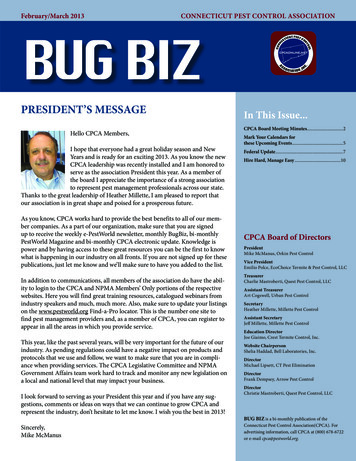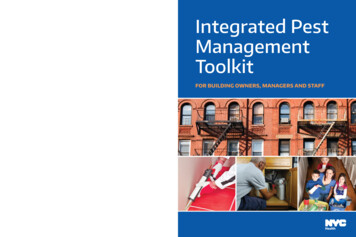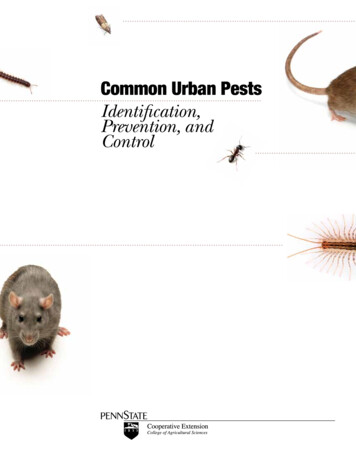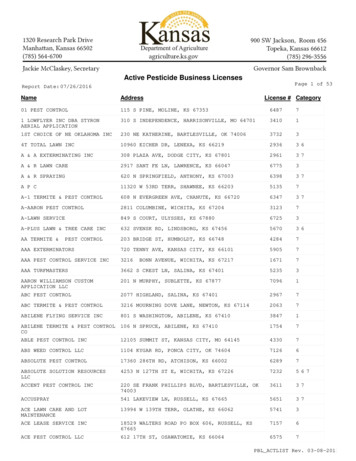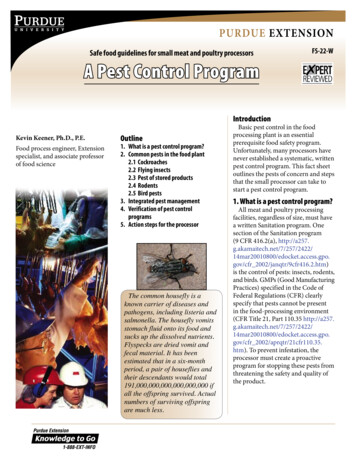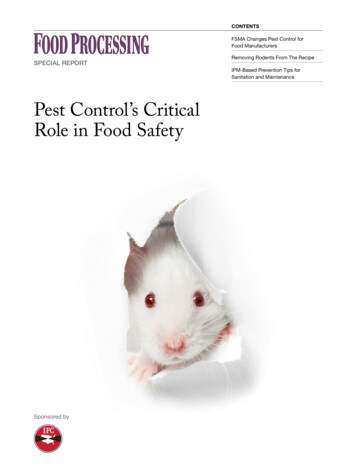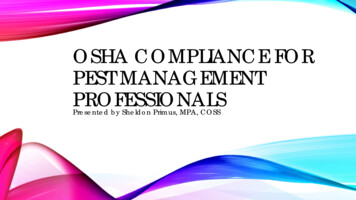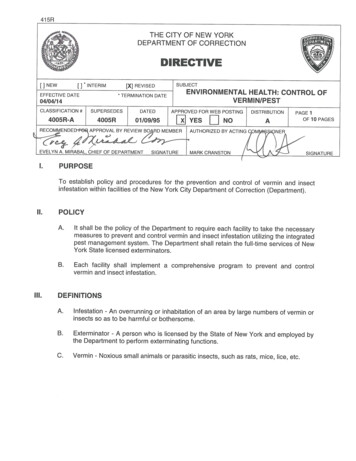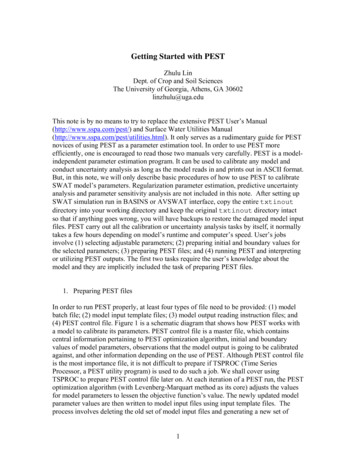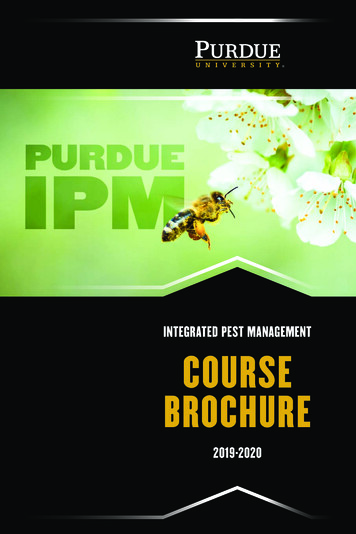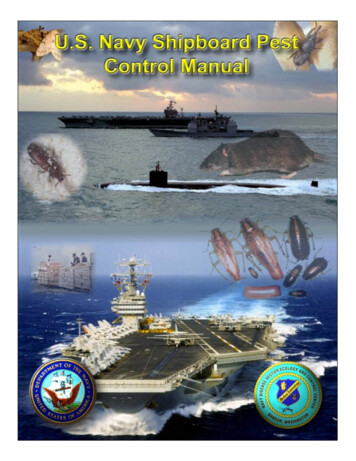
Transcription
PREFACEThis manual is the result of coordinated efforts to revise a multitude of relatedDoD and Navy shipboard guidelines, while widely recognizing the need to updatethe 1986 “Navy-wide shipboard pest control manual.” The intent of this revisedmanual is to provide current and effective guidance for the surveillance,exclusion and control of disease vectors and invasive pest species, which maythreaten the health and safety of personnel aboard U.S. naval vessels, or betransported between U.S. and foreign shores.At the date of publication of this manual, every effort has been made to referencethe most currently signed written guidance. Additional relevant references areunder revision, and will be included in the next version of this manual.The following individuals and institutions are gratefully acknowledged for theirefforts in compiling this edition of the “U.S. Navy Shipboard Pest ControlManual”:HMC C. Purdin initiated a first working draft from the 1986 version. Dr. W. Tozer,provided significant changes and updates to design, organization, content andformatting, and served as formal editor for earlier drafts through the final copy.The following individuals provided valuable suggestions or significantmodifications to various working drafts: CDR M. Mann, CDR R. Jacobs, CDR J.Corneil (also cover design), LT C. Stoops, LT P. Obenauer, HMC S. Berry, HM1M. Elam, HM1 J. McLearie, HM2 J. Mueller, HM2 J. Church (NDVECC, Bangor);LCDR S. Cope (NEHC, Norfolk, VA); LCDR S. Rankin (NEPMU-2, Norfolk, VA);LT M. Smith (NEPMU-7, Sigonella, Italy); CDR M. Beavers, LCDR S. Presley, LTT. Negus, Dr. A. Beck (NDVECC, Jacksonville). CDR M. Bangs, (NAMRU-2,Jakarta, Indonesia) provided an especially exhaustive and invaluable review of alater draft version. Mr. G. Walker, Defense Supply Center, Philadelphia, PA,kindly offered his expertise and assistance in revising the stored products pestsection, including Table 2-1.Through liaison with Dr. M. Mullen, Ms. B. Waters, USDA, ARS – U.S. GrainMarket Research Lab, Manhattan, KS, generously provided much appreciatedlab reared, live stored products pest specimens for digitally captured images.For permission to use: figs. 2-1, 2-2, C. Ogg, L.Schulze, and J. Kalisch, Univ.Nebraska – Lincoln; figs. 2-23 through 2-25, and 2-27 through 2-29, Courtesy ofthe Central Science Laboratory, U.K.; fig. 2-37, HMC Knapp; fig. 5-1, P.A. Grove,the Whitmire Micro-Gen Research Laboratories, Inc; figs. 2-26, 2-31 through 233 and Appendix E, U.S. Public Health Service, CDC, Atlanta, GA.Figs. 2-3 through 2-11; figs. 2-12, 2-21, and 2-22 digitally captured from U.S.Navy photos/films and figs. 2-13 through 2-20; figs. 2-35, 2-36 and 2-38 through2-40, Appendix F (lice photos), Dr. W. Tozer, NDVECC, Bangor, WA.i
DISCLAIMERTrade names are used in this manual to provide specific information and do notimply endorsement of the products named or criticism of similar ones notmentioned. Mention of trade names does not constitute a guarantee or warrantyof the products by the Navy Disease Vector Ecology Control Center, Bangor, theMilitary Services, or the Department of Defense (DoD).ii
TABLE OF CONTENTSPreface . IDisclaimer . iiChapter 1 Overview of the U.S. Navy Shipboard Pest Control ProgramIntroduction. 1Responsibilities . 1Education and Training Requirements . 3Chapter 2 Shipboard PestsIntroduction. 5The German Cockroach . 5Cockroach Control Aboard Surface Ships.11Cockroach Control Aboard Submarines .15Stored Products Pests (SPPs) .16Rodents .30Miscellaneous Shipboard Pests .36Chapter 3 Quarantine IssuesBackground .43U.S. Navy Vessels Entering U.S. Ports .44U.S. Navy Vessels Entering Foreign Ports .45Pierside/Onloading Inspections of Infestible Products .46Rodents and Rat Guards.46Deratting/Deratting Exemption Certification .46Chapter 4 Records and ReportsThe Pest Control Log .49Personnel Records.49Materiel Inventory Records.49Pierside/On-Board Inspection Records .49Deratting/Deratting Exemption Inspection Certificate Records.49Courtesy Technical Assistance Visit/Informal Survey.49Pesticide Use Records .49Pesticide Use .50Infested Products .50Chapter 5 PesticidesPesticide Label .53Pesticide Safety.54Medical Examinations and Cholinesterase Testing .56iiiTable of Contents
Personal Protective Equipment (PPE).59Procurement of Pesticides and Pesticide Dispersal Equipment .60Pesticide Storage .60Pesticide Mixing and Spills .61Chapter 6 Pesticide Dispersal EquipmentAerosol Container Pesticide Dispersal Unit.63Hand-Compressed Air Sprayer .67Appendix AAuthorized Shipboard Pesticide List .73Appendix BPest Control Equipment and Supplies.75Appendix CPersonal Protective Equipment.77Appendix DTechnical Information Memorandum 38: ProtectingMeal, Ready-to-Eat Rations (MREs) and OtherSubsistence during Storage (Selected Pages) .79Appendix ENavy Shipboard Pest Control Training Centers.89Appendix FTaxonomic Keys to Some Common Shipboard Pests .91Appendix GMIL-STD-904B . 103Appendix HDD Form 1222: Instructions, Blank and Sample Forms . 121Appendix INAVSUP P-486 Volume 1 Food Service Management5301, Hazardous Food Items (Selected Pages). 125Appendix JDoD Hazardous Food and Nonprescription Drug RecallSystem (NAVSUPINST 10110.8C, Selected Pages). 135Appendix KMaritime Health Declaration Form . 141Appendix LSample Deratting/Deratting Exemption Certificate. 143Appendix MShip’s Pesticide Inventory and Pierside Inspection LogEntry Samples. 145Appendix NRecording and Archiving Pesticide Use DuringMilitary Operations Memorandum, DASN (I & E) . 147Appendix OInstructions for the Use of the Pest Management UseRecord, DD Form 1532-1 . 149Appendix PPest Management Use Record,DD Form 1532-1 (Blank) . 155ivTable of Contents
Appendix QSample Pest Management Use Record,DD Form 1532-1 (Sample) . 157Appendix RReferences . 159vTable of Contents
CHAPTER 1OVERVIEW OF THE U.S. NAVY SHIPBOARDPEST CONTROL PROGRAMbeing of ship’s personnel, lead toloss of materiel, or affect thedeployment status of vessels.INTRODUCTIONThis manual outlines DoD, OPNAVand BUMED policies andprocedures, defines responsibilities,and provides detailed guidelines forthe U.S. Navy Shipboard PestControl Program. The informationcontained herein is the combinedeffort of Navy Medical Entomologistsand Preventive MedicineTechnicians to provide a "readyreference" to assist you inconducting a safe and effectiveprogram utilizing the concepts ofintegrated pest control. Yourdiligence in detecting potentialproblems and monitoring controlmeasures is essential. However,controlling pests aboard navalvessels requires the cooperativeeffort of all hands in maintaininggood sanitary standards inworkspaces, berthing and commonuse areas.The Senior MDR ensures anongoing shipboard pest controlprogram is maintained. The mainelements of an effective programare:RESPONSIBILITIESThe Commanding Officer of aNavy vessel must ensure the SeniorEnlisted Medical DepartmentRepresentative (MDR) and hospitalcorpsmen responsible for pestcontrol are certified in shipboard pestcontrol. Responsible corpsmen mustestablish and maintain a safe andeffective program for controllinginsects, rodents, and other pests thatmay affect the health and well1 Rodent Control: Maintaining acurrent Deratting/DerattingExemption Certificate and aneffective rodent exclusionprogram. Fumigation and CommercialContracts: Prohibiting fumigationof ships' spaces and prohibitingcommercial contracts for pestcontrol services aboard ship,unless specifically approved inwriting by a Navy MedicalEntomologist. Procurement of Pesticides,Pesticide Dispersal Equipment,and Personal ProtectiveEquipment (PPE): Ensuring allpesticides (Appendix A), pestcontrol equipment (Appendix B),and PPE (Appendix C) havebeen approved for use aboardnaval vessels by BUMED. ANavy Medical Entomologist mustbe contacted to receive approvalfor the procurement of nonstandard stock pesticides.Chapter 1 – Program Overview
Meals Ready to Eat (MREs):Maintaining a control program forMRE rations, to prevent materielloss from pest infestations(Appendix D). Inspections: Conducting ongoingpierside food acceptanceinspections and shipboard pestsurveillance (every two weeks, ormore often if necessary, as partof food sanitation inspections) toidentify the presence of any pestspecies, including sourcelocations and severity of theinfestations. Evaluating theeffectiveness of control measuresthrough follow-up post-treatmentsurveys. Sanitation: Recommendingappropriate sanitation proceduresto exclude or eliminate shipboardpests. Medical Surveillance:Coordinating laboratory testingand monitoring of required longterm medical surveillanceprocedures for shipboard pestcontrol specialists. Material Safety Data Sheets(MSDSs): Maintaining MSDSs forall pesticides stored or usedaboard ship. Record Keeping and Reporting:Maintaining an ongoing pestcontrol log, which adequatelydocuments pest controlprocedures and shipboard pestcontrol training conducted aboardship. Meeting mandated externalreporting requirements, includingdocumentation of pesticide use. Regulations and ProgramGuidance: Maintaining a basicreference library of writtenregulations and programguidance. A general list ofcurrent references covering pestcontrol is provided in Appendix E. Vessels with no assigned MDRshall obtain technical consultationand assistance from theircognizant preventive medicinepersonnel or the NDVECC orNEPMU.Pesticide Safety: Conducting andsupervising safe pest controloperations as outlined undercurrent BUMED instructions,including: Personal ProtectiveEquipment (PPE):Coordinating with theRespiratory Protection Officerand Safety Officer to ensureappropriate National Institutefor Occupational Safety andHealth (NIOSH) approvedpesticide respirators arereadily available for use (seeChapter 5).2Respiratory ProtectionProgram: Ensure that allpersonnel who perform pestcontrol operations areadequately trained inrespiratory protection andrespirator use, medicallyevaluated, and are receivingannual respirator fit-testing.Chapter 1 – Program Overview
management responsibilities onMilitary Sealift Command (MSC)ships may also be certified.Personnel of the MedicalDepartment of the U.S. Coast Guardmay be trained and certified inshipboard pest control.Navy Medical Entomologistsassigned to Navy Disease VectorEcology and Control Centers(NDVECCs) and NavyEnvironmental and PreventiveMedicine Units (NEPMUs) overseethe shipboard pest control program.This oversight is achieved by: Providing guidance, on-siteconsultation, technicalassistance, andrecommendations to fleetcommands on all matters relatingto shipboard pest control.Commands requesting pestcontrol services are responsiblefor adequately preparing spacesfor treatment with pesticides andmust provide post-treatmentclean up. Conducting education andtraining of selected personnel forcertification as shipboard pestcontrol specialists, followingprocedures outlined inBUMEDINST 6250.12C. Mess Control Specialists, WatchCaptains, Mess Deck Masters-AtArms, And Break-Out Or Cargopersonnel not assigned to MSCships should be encouraged toattend shipboard pest control trainingto increase their understanding ofsanitation practices related toshipboard pest control, pestrecognition, and proper preparationof spaces before and after pesticidesare applied. Although thesepersonnel will not receivecertification, they may assist theMDR in applying pesticides, whendirectly supervised by certifiedpersonnel.Certification Training consistsof one day of classroom (didactic)instruction and one-half day of fieldtraining aboard a ship or vessel.Classroom training is conductedunder the supervision of a NavyMedical Entomologist currentlycertified as a DoD PesticideApplicator in Category 8. A writtenexamination with a minimum passingscore of at least 70 percent must beachieved.Reviewing and evaluating all pestcontrol procedures, pesticides,pesticide dispersal equipment,and new technologies beforeapproval for shipboard use.EDUCATION & TRAININGREQUIREMENTSMedical DepartmentPersonnel responsible for pestcontrol operations mustbe certified to conduct shipboardpest control operations by attendingand successfully completing theShipboard Pest Control Course (CIN:B-322-1075). Ship’s stewards orother personnel assigned pest3Chapter 1 – Program Overview
contacting these activities (AppendixE).ClassroomconsistOverviewof:Chapter 1topics– ProgramSubjectHoursCourse Introduction andAdministrative Requirements. 0.75Program Responsibilitiesand Training. .0.25Biology, Surveillanceand Control of: Cockroaches Stored Products Insects, Rodents MiscellaneousShipboard Pests. . 2.50Quarantine Issues. 1.00Pesticides Recording and Reporting PesticideUse Safety, Health & PersonalProtective Equipment Pesticides & Pesticide DispersalEquipment - Use andProcurement. 2.50Review and Examination. 1.00Total Classroom Hours. 8.00After ship’s personnel havecompleted the classroom portion ofthe course, the MDR may schedulethe field training directly with thecourse’s lead instructor or throughthe training department of thecognizant NDVECC or NEPMU. Therequirement for field training aboarda vessel should be completed nolater than 1-week after the classroomphase. A certificate of completionwill not be issued until both phasesof training are completed.Annual training is required to retaincertification.Classes are routinely conducted bythe NDVECCs and NEPMUs.Information on class conveningdates and quotas can be obtained by4Chapter 1 – Program Overview
CHAPTER 2SHIPBOARD PESTSlower crew morale. The constructioncharacteristics of naval vesselsmake cockroach control verychallenging. Abundant standingwater, food, warmth, and numerouspotential harborages provide thecockroach with an ideal habitat forgrowth and survival. Their habits andbody structure enable them topotentially transmit pathogens thatcause dysentery and diarrhea.Cockroaches also impart a foul odorwhere infestations are wellestablished. Their presenceindicates inadequate sanitarypractices or ineffective cockroachcontrol measures. MedicalDepartment personnel mustunderstand the biologicalcharacteristics of Germancockroaches to provide an effectivecontrol program.INTRODUCTIONGlobal presence and the increasedoperating tempo of naval forcesgreatly increase the chances ofencountering pests that transmitpathogens, infest food supplies, orsimply present a nuisance to crewmembers. This manual concentrateson the biology, surveillance, andcontrol strategies of pests that arecommonly found aboard ships.Taxonomic keys to common pestsare presented in Appendix F. Thesepests are prone to inhabit certainareas, making continual monitoringimportant for the following spaces: Food service areas.Sculleries.Mess decks.Ship's stores (e.g., soda storageareas).Snack areas.Heads and showers.Dry provision storage areas.Berthing areas.Laundry and dry-cleaning shops.Cleaning gear locker.Garbage collection areas.BiologyThe German cockroach (Fig. 2-1a, b,c) is a small, flattened, light browninsect which can be easily identifiedfrom other cockroaches (Fig. 2-2) bythe presence of two dark longitudinalstripes behind the head(“Lieutenant’s bars”). Adult Germancockroaches are approximately onehalf inch long. Adult femalecockroaches produce a visible eggcapsule (called an ootheca) locatedat the tip of the abdomen (Fig. 2-1b,d). The egg capsule protects thedeveloping 30-40 eggs until they areready to hatch. Gravid females maycarry the egg capsule up to threeTHE GERMANCOCKROACHImportanceThe German cockroach, Blatellagermanica, is the most commonlyencountered pest aboard Navyships. Cockroaches contaminatefood and food preparation areas, and5Chapter 2 – Shipboard Pests
weeks, until the eggs are within 24hours of hatching. The youngcockroaches, are called nymphs andlook very similar to the adults. Thenymphs shed their skins (molt)several times as they mature. Asthis process continues, theygradually develop wings andincrease in size. Depending uponenvironmental factors (temperature,moisture, food supply), nymphs willfully mature in 40 to 60 days. Theadults are characterized byfunctional wings and sexual maturity.Adults can live up to one year and asingle female is capable of producingup to six egg capsules during herlifetime.Fig. 2-1. German cockroach(Blatella germanica). a male; b female; c nymph; d egg capsule.German cockroaches require food,water, warmth, and harborages(cracks and crevices usually lessthan 1/2-inch wide) for growth andsurvival. Their flattened bodiesenable them to hide in tight placesthat are warm and dark. Eventhough their exoskeleton is coveredwith a thin, water-resistant waxycoating, they are especially intolerantof dry areas and will instead befound close to available sources ofwater. German cockroaches arenocturnal and gregarious in habit.Typically, the cockroach spendsapproximately 80 percent of the timein the harborage and the remaining20 percent foraging within a few feetof an established harborage.Studies have shown cockroachesprefer to have their body pressedagainst a solid surface in smallcracks and crevices (positivethigmotaxis).Fig. 2-2. Comparison of somecommon household cockroaches.Surveillance ProceduresA visual inspection for cockroachharborages is an essential part of asuccessful control program. Earlyidentification of sites of cockroachinfestations will reduce the need toapply pesticides by eliminating thebreeding sources. Frequentinspections are especially important,because light infestations usually gounnoticed by ship’s personnel untilthe infestation becomes moredifficult to control.6Chapter 2 – Shipboard Pests
Cockroaches normally forage indarkness. Therefore, if cockroachesare seen in lighted conditions, it mayindicate (1) that an extremely largepopulation exists in overcrowdedharborages, resulting in overflow intothe ship’s spaces, or (2) that aharborage has been disturbed,causing the cockroaches to disperse.Additionally, the presence ofimmature and adult cockroaches inthe same harborages often indicatesa well-established infestation. Oncoming food stores (e.g.,bagged onions, potatoes), softdrink containers, and cardboardcontainers.Ovens and oven hoods.Motor housings, esp., inrefrigeration units, ice creammachines (Fig. 2-3).Cockroaches may also be located inareas not normally surveyed and theinfestation may quickly increaseunnoticed. The goal of cockroachcontrol will be met only when allharborages are located and properlytreated or eliminated.The shipboard pest control specialistshould conduct a cockroach surveyevery two weeks in food serviceareas, and weekly untilcockroaches are no longerpresent. Infestations are most likelyto be in and around: Fig. 2-3. Ice cream machine andmotor housing. Steam lines.Cable bundlesBerthingFalse bulkheads, overheads, andsplash boards.Lagging and torn insulation.Behind pictures and bulletinboards.Around holes for plumbing andelectrical lines.Behind drawers.Around iron supports of countersand serving lines.In hollow furniture and utility legs(e.g., refrigeration and heavyequipment supports).Deck drains (Fig. 2-4).Fig. 2-4. Deck drain.7Chapter 2 – Shipboard Pests
Sinks and drains (Fig. 2-5).Behind stainless steel plates andventilation grating (Fig. 2-7).Fig. 2-7. Ventilation grating. Fig. 2-5. Deep sinks. In expansion joints and underpipe insulation (Fig. 2-8).Steam kettles (Fig. 2-6).Fig. 2-8. Potential harborage underpipe insulation.Fig. 2-6. Steam kettles.8Chapter 2 – Shipboard Pests
Often the pest control specialist muststoop and crawl to locateharborages. The presence ofcockroach feces is a good indicationof an active or past cockroachpopulation. Cockroach feces appearas small, straw-colored to reddishdark brown dots near harboragesand infested containers.Inside electrical switch, fuse box,and valve junction panels (Figs.2-9, 2-10).Special inspection techniques arenecessary to locate cockroachresting sites and harborages. Aflashlight is essential when searchingfor cockroach harborages in dark ordimly lit areas. A screwdriver is alsoneeded to remove screen guardsand motor housing covers(Remember to disconnect power tothe motor before removing thehousing). Replace guards andhousings after inspection. Requestassistance from engineeringdepartment personnel, whennecessary.Fig. 2-9. Breaker panel.Flushing AgentsFlushing agents are useful inlocating cockroaches and theirharborages. Flushing agents consistof an aerosol pesticide formulation ofsynthetic pyrethroids, such as DPhenothrin (Appendix A). Spray asmall amount of flushing agent intopotential harborages using the tipextender on the aerosol can andobserve the area for 3 to 5 minutesfor cockroach activity. Flushingagents will produce a quickresponse, if cockroaches arepresent. The best technique is tospray all suspected harborages in aspecific area and then return to thefirst harborage sprayed and look forany cockroach activity (use aflashlight, if necessary). Because ofits repellent properties, do not applyd-phenothrin around bait stations orFig. 2-10. Valve junction panel. Unsecured debris (Fig. 2-11).Fig. 2-11. Unsecured packingmaterial.9Chapter 2 – Shipboard Pests
covering are commercially available,and in the stock system (AppendixB).surfaces treated with boric acidaerosol dust.Use caution in areas with electricalor fire hazards and never spray foodpreparation surfaces or equipment.Food cannot be prepared, served, orconsumed during pesticideapplication. When using a flushingagent during pierside receiptinspections, avoid spraying the agentdirectly on food or food packages.PreventionConduct pierside acceptanceinspections (random selection) whenstores are coming aboard. This is acritical element of the shipboard pestcontrol program while in port.German cockroaches may bebrought aboard the ship in the egg,nymph, or adult stages. Inspectpotatoes, onions, soda cases, bakedproducts, milk products, and anycardboard box pierside. Segregateand remove infested items frompacking material. Ensure items arefree of cockroaches before bringingthem aboard the ship. Personalitems carried aboard bycrewmembers may also be infestedwith pests.Cockroach TrapsCockroach traps (either toxic ornontoxic) are useful survey tools todetect low-level populations, locateharborages, and determine theeffectiveness of treatment. Trappingalone will not eliminate aninfestation.Traps may consist of a rectangularbox, a glass jar, or similar containerwhich holds an attractant (e.g.,manufacturer supplied bait, slice ofbanana, fresh bread) to lure theinsect into the trap. Spread anextremely thin layer of petroleumjelly just under the inside opening ofthe jar trap to prevent cockroachesfrom leaving the container.Preventive control strategies canreduce or eliminate mostcockroach infestations by denyingcockroaches the basic requirementsfor growth and survival. Thisincludes preventing cockroachesfrom accessing food, water, warmth,and harborages, as well as excludingcockroaches from supplies beingbrought aboard ship. Use preventivecontrol measures on a continuousbasis even in the absence of acockroach infestation. Not only arepreventive measures effective inavoiding infestations, they alsoaugment corrective controlmeasures.Place traps near suspectedharborages and allow them toremain in place for at least 24 hours.Place traps in the same locationseach time. For best results, placethem in dark areas along bulkheadsor in corners. Do not place traps inareas that are wet. Count thetrapped cockroaches and record theresults in your pest control log. Iftwo or more cockroaches per trapare caught in a 24-hour period,pesticide treatment may benecessary. Traps with a glue board(sticky trap) and a protectiveA high-level of sanitation is the firststep to effective cockroach control.Store foods correctly, maintain goodhousekeeping, and eliminate waterleaks and spills. In summary, thefour key factors that continue to10Chapter 2 – Shipboard Pests
support cockroach infestations, andfrom which they must be deniedaccess to, are:HarboragesGerman cockroaches prefer verysmall cracks and crevices(harborages) for resting and hiding.All cracks and crevices should besuspected as harborage areas forcockroaches. Cockroachpopulations will be severely stressedif harborages are reduced oreliminated.FoodCockroaches can exist on very smallamounts of food. Strict adherence tothe following guidelines will limit theincrease of cockroach populations: Proper food handling techniques.Store food and garbage incontainers with tight fitting lids toprevent access to foragingcockroaches.Clean food preparation areas,equipment, and eating utensilsthoroughly after each use.Clean food spills immediately.Prohibit food consumption inberthing areas. WaterGerman cockroaches require areadily available source of water.Preventing access to water will affectpopulation reproduction andsurvivability. To accomplish this: Eliminate water leaks.Store wet swabs with the headup.Repair clogged drains andeliminate standing water. Seal cracks and crevices with acaulking compound only when allcockroach access is eliminated.Incomplete sealing of cracks andcrevices will provide a “safezone” for the cockroachpopulation by sealing sites wherepesticides would normally beapplied. If in doubt, do not seal.Repair torn, deteriorated, ordamaged lagging and insulation.Check with engineeringdepartment personnel to repair orremove insulation and lagging.Promptly remove cardboard andcardboard boxes from foodservice areas.Prohibit the use of shelf liners.Eliminate false overheads andbulkheads, if possible.Eliminate unnecessary metalcoverings or flashing.COCKROACH CONTROLABOARD SURFACESHIPSWarmthCockroaches can be found in andaround warm, sheltered areas. Foodpackages such as baked goods,bags of potatoes or onions, andother containers with signs ofcockroach infestation can be placedin a refrigerator to kill thecockroaches. Cockroaches will bekilled within 48 to 72 hours at freezertemperatures (0oF).When cockroach populationsbecome established, it may becomenecessary to apply insecticides toeliminate the infestation. This isaccomplished through the use ofdust, liquid, aerosol, and baitpesticide formulations. Conduct athorough pre-treatment surveybefore initiating corrective actions.11Chapter 2 – Shipboard Pests
type of vessel, insecticide to beused, and severity of the cockroachinfestation.The only certain way to assesseffectiveness of treatment is tocompare pre-treatment surveys withpost-treatment surveys. Actualtreatment must be performed bycertified shipboard pest controlspecialists. Conduct a complete field day,ensuring a thorough “deepcleaning” of all surfaces, asgrease and dirt will reduce theeffectiveness of the appliedpesticide.
Personnel responsible for pest control operations must be certified to conduct shipboard pest control operations by attending and successfully completing the Shipboard Pest Control Course (CIN: B-322-1075). Ship's stewards or other personnel assigned pest management responsibilities on Military Sealift Command (MSC) ships may also be certified.

